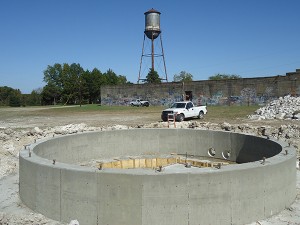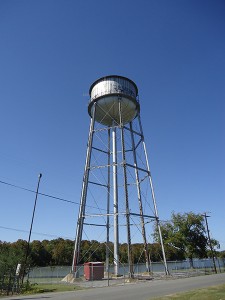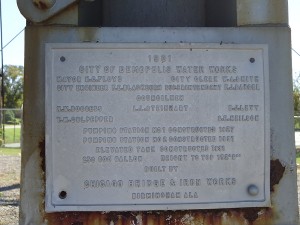Water project creates point of contention

A $3 million water project that has been in the works for approximately two years has recently sparked controversy where it concerns the city’s Historical Preservation Commission.
The project, which will call for the renovation of three towers operated by the Demopolis Water Board, will also see the construction of a new tower to act as a replacement for the structure that has sat between the river and North Commissioners Avenue since it was erected in 1931.
“One of the stages of this project is to build a water tower. One stage is to rehabilitate three existing tanks in our system,” Brooks McCants, head of the Demopolis Water Board, said. “The third stage that will be bid out is that there will be a line installed that pumps water straight from well No. 1 all the way to this new storage tank.”
The project has not set well with the preservation commission for a number of reasons ranging from the location and style of the new tower to the likely demolition that awaits the old tower. At the heart of the group’s concerns, according to commission member Brian Brooker, is the notion that the new tower will take away from the character of the city’s historic district.
“We have recently found out that the water board is installin

g a new water tower on top of White Bluff, which is a nationally registered, listed historic site,” Brooker told the Demopolis City Council at a meeting earlier this month. “And that is just within sight of downtown, which is also a nationally registered district; city park, which is a nationally registered site, Bluff Hall, Lyon Hall, Ash Cottage, numerous others that are considered significant with our respect.”
According to McCants, the White Bluff location of the tower came about after a long process of elimination that saw the board work its way through five other potential sites for the tower.
The water board considered placing the tower behind the old jailhouse on Fulton Street, but rejected that site when it became apparent that the site would require significant excavation.
The old Mr. G’s location had been a serious consideration for the new water tower but was ultimately eliminated due, in part, to the fact that the accompanying 10-foot tall fence with barbed wire lining the top that will surround the tower would be just a few yards from the road.
“. The other thing about that location was that the owner had been approached by the water board or some affiliation of the water board about selling it and he wanted a large amount of money for the property, almost double what we ended up paying for ours,” McCants said.
A potential site near Childers Street and Highway 43 was a possibility until research showed the water board would have to spend more than $100,000 before it could begin laying a foundation.

“Another location is the open field directly east of the tennis courts. We abandoned that because we figured that it was unfair for the people who live in that location because they have a direct view, somewhat, of the river,” McCants said. “And if we were to build a tower there, we would obstruct their view of the river.”
The potential water tower site that offered the most promise before ultimately being ruled out was the location at the city landing near the playground. McCants said the presence of the playground coupled with the site’s appeal for many Christmas on the River visitors outweighed the construction-friendly nature of the location.
“At that point, we really didn’t like any of those sites but those are the locations I had when I walked through the door,” McCants, who inherited the project when he took over his position approximately a year and a half ago, said. “We went out looking for another site that had better foundation work, was at a higher elevation so the tank would have to be shorter, so to speak, in materials because the higher the elevation, the shorter you actually have to build the tank itself. It makes a cheaper tank. We got to looking around and the owners over there in that area, we talked to some of them and they were willing to sell us three lots together plus give us a 12-month construction easement on the adjoining properties so that the construction people could actually park their equipment. It just gave us a nice area to have a laydown area. It was wide open and wouldn’t interfere with anybody’s view of the river, anybody’s use of the river and so forth and there was already a tower in that location with a cell phone tower.”
“We’re just really concerned about what impact that is going to have on the historic character of our downtown, our park, our city park, all the historic sites that are around it,” Brooker said of the potential aesthetic impact of the new tower. We feel like our purpose is to try and assist in these type things. We actually went to the water board last year when we first heard about it and we requested to attend one of their meetings to discuss our concerns about two things. One being that the existing water tower that is down in the city landing area now is listed on the survey that Demopolis had done in 2005 as one of our current existing historic resources, that type of tower, the tin tub style, its age and the fact that it has become such an icon to create a sense of place at the arrival to Demopolis both by waterfront and by Highway 43. That was our first concern was that it was scheduled for demolition. We wondered why. Could it not have been maintained and/or restored?”
McCants said the concerns of the commission were heard and did make an impact in the water board’s decision about where to place the new tower.
“No. 1 factor for picking that site was the first concern that the historical society had about the tank being visible from the river bridge because they wanted it to be the first thing that people saw when entering from the Greene County and Marengo County bridge,” McCants said. “The second factor was they wanted it to be visible as a navigational beacon along the riverside. Third, it was one of the better locations of the ones that we had already considered.”
While the tower will be visible from the bridge near Marengo County’s northern border and the site offers favorable construction opportunities for the water board, the commission is concerned the erection of such a tower on the White Bluffs will greatly detract from the visual appeal of the downtown area and its historic sites.
“We don’t want it to be a dead issue. We’d still like there to be some consideration about what that tower looks like and where it is going so that it doesn’t just add visual clutter to the river bank on top of White Bluff,” Brooker said. “We’re taking an iconic image of this town and changing it quite a bit and we don’t feel like that was done with a lot of public input or knowledge.”
McCants said the water board considered the commission’s feelings regarding the issue of visual clutter on the bluffs.
“Since there is a tower right next to (the site where the new tower is being built), we didn’t think it would be a big deal. We’ve heard some concerns about putting towers on the pristine bluffs. There’s already two on the bluffs,” McCants said. “We’re building a third and then the future plans are to either pass off ownership of the old tower or demolish it and then you’ll still have two towers on the bluffs. So we’re not really adding a tower to the bluffs.”
With the location of the water tower locked in, the commission indicated it would like to see a tower similar in style to the leg tower or what it calls a “tin tub style” tower built on the new site. Such a tower, the commission feels, would minimize the damage done to the visual climate of the historic district. Instead, the water board is opting for a pedestal tower, a structure Brooker likens to a golf ball on a tee.
“For us, we want the pedestal tower for several reasons. One being that the tower is easier to maintain and cheaper to paint because you don’t have to worry about maintaining and painting all of the turnbuckles and individual legs,” McCants said. “You have a larger surface area to just blast and paint when it comes time to paint it. The other decision that had to do with it was the ability of us as a water department to actually climb the tank. You’re encapsulated inside the pedestal, which makes it a safer climb into the bowl instead of climbing the outside of the tank and getting on the rails for tank washouts that are required by ADEM regulations.”
The project is necessary because the current tank is in disrepair with considerable problems existing with the structures inside the tank as well as on the bowl itself, problems that were initially revealed after a study done in 1997.
McCants indicated that the new tower will have “Demopolis” painted on it in a script font, a concession that was made at the request of a commission member.
“I think that (the commission’s) concerns are legitimate but we have to move forward. I know that the water board did not enter into this thing on just a quick, shoot-from-the-hip type decision. I know that they studied and what they came up with was the best option for the long-term viability of the city,” Demopolis Mayor Mike Grayson said of the issue. “I think if we had put (the tower) anywhere, there was going to be somebody that was going to be upset and think that perhaps it was not done correctly and that sort of thing. I think the history of this town is important, but it is just that, the history. You’ve got to take that into consideration, but we’ve also got to move forward.”

